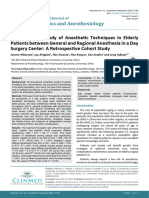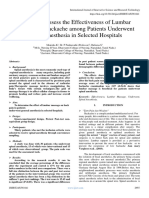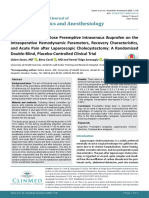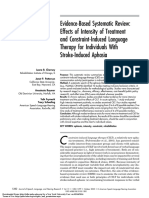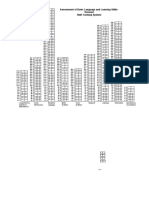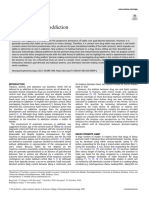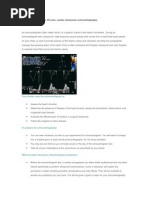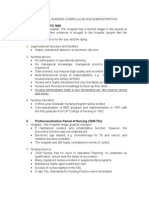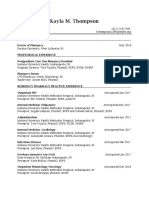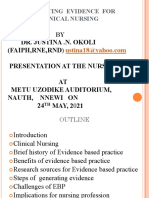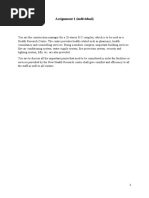07 Steyaert
07 Steyaert
Uploaded by
GokushimakCopyright:
Available Formats
07 Steyaert
07 Steyaert
Uploaded by
GokushimakOriginal Title
Copyright
Available Formats
Share this document
Did you find this document useful?
Is this content inappropriate?
Copyright:
Available Formats
07 Steyaert
07 Steyaert
Uploaded by
GokushimakCopyright:
Available Formats
See discussions, stats, and author profiles for this publication at: https://www.researchgate.
net/publication/341990019
Transcranial direct current stimulation as a tool for postoperative pain
management : a review of the current clinical evidence
Article in Acta anaesthesiologica Belgica · October 2019
CITATIONS READS
2 131
4 authors:
Arnaud Steyaert Cédric Lenoir
Université Catholique de Louvain - UCLouvain Université Catholique de Louvain - UCLouvain
40 PUBLICATIONS 591 CITATIONS 19 PUBLICATIONS 141 CITATIONS
SEE PROFILE SEE PROFILE
P. Lavandhomme André Mouraux
Université Catholique de Louvain - UCLouvain Université Catholique de Louvain - UCLouvain
137 PUBLICATIONS 5,457 CITATIONS 240 PUBLICATIONS 8,942 CITATIONS
SEE PROFILE SEE PROFILE
Some of the authors of this publication are also working on these related projects:
APPLICABILITY OF THE ‘‘SNIFFIN’ STICKS‘’ TEST IN A NORMAL POPULATION OF SOUTH-KIVU (D.R.CONGO) AND DEVELOPMENT OF CULTURALLY ADAPTED VERSION View
project
Deep cTBS of the operculo-insular cortex View project
All content following this page was uploaded by Arnaud Steyaert on 07 June 2020.
The user has requested enhancement of the downloaded file.
(Acta Anaesth. Belg., 2019, 70, 173-181)
Transcranial direct current stimulation as a tool for postoperative
pain management : a review of the current clinical evidence
A. Steyaert (*,**), C. Lenoir (*,***), P. Lavand’homme (*,**), A. Mouraux (*)
Abstract : Adequate control of acute postoperative pain is defined as pain that develops after a surgical
remains a challenge, and many patients still experience procedure and persists at least three months, when
moderate to severe pain. Surgery is also a major cause all other causes of pain (e.g. infection, recurring
of chronic pain, which cannot reliably be prevented with malignancy, …), as well as pain from a pre-existing
available interventions. Current analgesic regimens are pain problem have been excluded (8). CPSP affects
also associated with severe side-effects. Consequently,
up to 50% of patients after common surgical
we are in need of new techniques to better manage pain
in the perioperative period. Transcranial direct current
procedures, worsening quality of life and increasing
stimulation (tDCS) – a non-invasive neuromodulation health care use (9). Chronic pain is hard to treat,
technique – affects pain perception in human volunteers. but the programmed nature of the surgical trauma
Its ease of use, relatively low cost and absence of serious could offer a window of opportunity for primary
side effects make it an ideal candidate for clinical preventive measures (10). Unfortunately, a recent
practice and a recent review concluded that it reduces review of the available perioperative interventions
pain intensity and improves quality of life of chronic pain for CPSP prevention concluded that, currently, none
patients. This article aims to review the clinical evidence reliably prevent its development (11).
for its use as a tool for postoperative pain management. The non-invasive application of electrical
In summary, seven randomized controlled trials have currents to the brain and the spinal cord has been used
included over 310 patients and report encouraging results, in research and clinical practice since the beginning
most notably a considerable reduction in postoperative
of the 20th century (12). Among the various forms
opioid use. More studies are needed to better establish
the place of tDCS in this setting and to determine the
of non-invasive brain stimulation techniques, tDCS
optimal stimulation protocols. has several characteristics, which make it an ideal
candidate for clinical use : low risk, non-invasive
Keywords : Postoperative pain ; transcranial direct cur- and painless, lack of serious side effects, ease of
rent stimulation ; analgesia administration and relatively low cost (13). Because
participants only feel a light tingling sensation
during the first minutes of stimulation, regardless of
Introduction stimulation duration, adequate patient blinding can
be obtained in clinical trials by delivering a very short
Despite currently used analgesic techniques,
adequate control of acute postoperative pain
remains a challenge, and many patients still Arnaud Steyaert MD, Cédric Lenoir PT, PhD, Patricia
experience moderate to severe pain after their Lavand’homme MD, PhD, André Mouraux MD, PhD
surgery (1). Unrelieved pain is associated with (*) Institute of Neurosciences, Université Catholique de
Louvain, Belgium
increased morbidity, functional and quality-of-life (**) Department of Anesthesiology, Cliniques Universitaires
impairment, delayed recovery, higher health care Saint-Luc, Belgium
costs, and prolonged opioid use (2). Moreover, (***) Department of Neuroscience, Physiology and
Pharmacology, University College London, UK.
current postoperative analgesic regimens are Corresponding author : Arnaud Steyaert, MD, Department
associated with severe side effects, including long- of Anesthesiology, Cliniques Universitaires Saint-Luc, av.
term opioid use, misuse, and addiction (3). Recent Hippocrate 10, 1200 Woluwé-St-Lambert, Belgium.
E-mail : arnaud.steyaert@uclouvain.be
studies have also raised security concerns with other
analgesic drugs, e.g. an increased risk of respiratory Paper submitted on Jul 07, 2019 and accepted on Nov 20, 2019.
depression when gabapentin (4) or pregabalin (5) Conflict of interest : Arnaud Steyaert is supported by research
are combined with opioids. grants of the Society of Anesthesia and Resuscitation
of Belgium and of the Fonds de Recherche Clinique.
Surgery is also a frequent cause of persistent Cédric Lenoir is supported by the Wellcome Trust (COLL
pain (6, 7). Chronic postsurgical pain (CPSP) JLARAXR).
© Acta Anæsthesiologica Belgica, 2019, 70, n° 4
07-Steyaert.indd 173 22/01/2020 09:04
174 a. steyaert et al.
et al. (19) showed that one 10-minute session of
anodal HD-tDCS over M1 significantly increases
pain pressure thresholds as well as the magnitude
of conditioned pain modulation (CPM). Earlier,
Borckardt et al. (20) demonstrated that a single
session of anodal HD-tDCS over M1 significantly
reduces the slope of temporal summation of thermal
pain in healthy volunteers. Anodal tDCS over M1
also reduces the intensity and extent of mechanical
secondary hyperalgesia induced by capsaicin-
heat application, possibly through the activation
of descending pain modulation pathways (21).
Fig. 1 — Left: anatomical location of areas commonly targeted Moreover, a recent Cochrane review concluded
with tDCS for pain control: dorsolateral prefrontal cortex
that there is evidence – albeit of low-quality – that
(DLPFC) and primary motor cortex (M1) ; middle: wide-
spread electrical field generated by a traditional tDCS montage, tDCS of M1 or DLPFC reduces pain intensity and
using two sponge electrodes ; right: more focalized electrical improves quality of life in chronic pain patients (22).
field generated by an optimized HD-tDCS montage, using 8 In the present article, we aim to review the
electrodes (adapted with permission from (58)). current clinical evidence for the use of tDCS in the
management of acute postoperative pain.
stimulation mimicking the initial experienced scalp
sensations at the beginning of real stimulation (13). Methods
During tDCS, a weak direct electrical current
is delivered through two or more electrodes placed We performed a PubMed search (up to
on the subject’s scalp. The resulting physiological December 2018) with the following terms : ‘post-
effects depend on several parameters (13). First, operative pain’ OR ‘postsurgical pain’ AND ‘trans-
the targeted brain structures (Figure 1, left) are cranial direct current stimulation’ OR ‘tDCS’,
of importance. For pain relief, these are most focusing on adult randomized, controlled trials. We
commonly the primary motor cortex (M1) (14) or excluded studies not available in English or French
the dorsolateral prefrontal cortex (DLPFC) (15). language. All titles and abstracts were examined to
Second, the type and configuration of electrodes exclude irrelevant studies.
have an influence. Originally, two large sponge We extracted data about participants (number
electrodes were used, resulting in a rather widespread of patients, gender), intervention (tDCS montage,
electric field (Figure 1, middle). More recently, number, timing, and duration of sessions, current
the use of several smaller electrodes, referred to intensity, polarity, electrodes’ size, current density),
as high-definition tDCS (HD-tDCS) with at least control condition (sham stimulation), adverse
one ‘active’ electrode surrounded by four or more events, and outcomes (opioid use, pain scores).
‘return’ electrodes, has demonstrated improved
focus of the stimulation (Figure 1, right) (13,16). Results
Third, the polarity of the active electrode located
over the target makes a difference. It is commonly Our literature search retrieved seven rando-
reported that the anodal electrode over the target mized controlled trials investigating the use of
region increases its excitability, while the cathodal tDCS as a postoperative pain management tool. We
electrode decreases it (17). Fourth, the current dose present the characteristics of each study in Tables 1
is thought to determine the effectiveness of the to 3 and summarize their findings in the text below.
neuromodulation. It is determined by the intensity In 2013, Dubois et al. randomized 59 patients
and duration of the stimulation, commonly set to 1 scheduled for lumbar spine surgery to receive
or 2 mA and 20 minutes, respectively (13). a single session of anodal, cathodal or sham
Several studies have demonstrated that tDCS tDCS over the left DLPFC (23). Anesthesia and
alters pain perception in humans. A recent meta- postoperative analgesia were standardized. Patients
analysis concluded that anodal tDCS of M1 but not underwent stimulation in the recovery room.
of the primary somatosensory cortex (S1) increases Outcomes – morphine consumption and pain levels
sensory detection and pain thresholds in healthy over the two first postoperative days – were similar
volunteers and decreases pain levels in chronic in both groups. No serious adverse events were
pain patients (18). In a study on healthy men, Flood noted. About half of the patients described some
© Acta Anæsthesiologica Belgica, 2019, 70, n° 4
07-Steyaert.indd 174 22/01/2020 09:04
tdcs and postoperative pain 175
mild itching under the electrodes and one patient in (Leeds Assessment of Neuropathic Symptoms and
the cathodal group experienced a visual flash at the Signs questionnaire and pain scores) were similar.
start of the stimulation. Adverse events were not reported.
Borckardt et al. randomly assigned 40 patients Ribeiro et al. conducted a double blinded,
scheduled for unilateral total knee arthroplasty sham-controlled, randomized trial, where patients
(TKA) to receive four 20-minute sessions of real (n scheduled for hallux valgus surgery were assigned
= 20) or sham tDCS (n = 20) (24). The anode was to receive two preoperative 20-minute sessions of
positioned over M1 – contralateral to the operated either anodal or sham tDCS over M1 (28). The first
knee – and the cathode over the right DLPFC. session was planned the night before surgery, and the
Patients received two sessions on the day of surgery second in the morning before the procedure. Patients
and two sessions on the first post-operative day. in the real tDCS group reported significantly lower
Patients who had received real tDCS consumed pain scores and needed less opioids than patients
significantly less opioids up to 48 hours after assigned to the sham group. Adverse events were
surgery, without reporting higher pain. Adverse not reported.
events were not reported. In 2018, Jiang et al. reported the findings of
In a follow-up study, Borckardt et al. enrolled a single-blind, randomized, sham-controlled trial
61 patients undergoing TKA and randomly assigned including 32 patients having underwent lumbar
them to one of four groups : (A) anode : M1, spine surgery (29). On postoperative day one, half
cathode : right DLPFC ; (B) anode : left DLPFC, of the patients received one 20-minutes session of
cathode : primary somatosensory cortex ; (C) anodal tDCS over M1, while the other half received
anode : left temporal-occipital junction, cathode : sham tDCS. Patients in the real tDCS group
medial anterior pre-motor area (active-control con- saw their pain intensity significantly decreased
dition) ; (D) sham tDCS, with electrode placement immediately after the intervention, while no effect
similar to group A or B (randomly selected) (25). was seen in the sham group. Interestingly, changes
The timing of the sessions was the same as in in pain intensity were correlated with changes in
their previous study. Anodal stimulation over alpha and beta bands of the spectral power of the
the DLPFC decreased opioid consumption as EEG in frontal regions. Some patients complained
compared to anodal stimulation over M1 and to about mild discomfort during the first minutes of
sham. Surprisingly, anodal tDCS over M1 increased stimulation, which did not require its interruption.
opioid consumption. Pain scores were similar in all
groups and no serious adverse events were reported. Discussion
Glazer et al. included lumbar spine surgery
patients in a randomized, double-blind, sham- In summary, seven randomized clinical trials
controlled clinical trial (26). Twenty-seven patients (310 patients) have investigated the effect of tDCS
received four 20-minute sessions of either active on postoperative opioid consumption and pain
or sham tDCS, with the anode positioned over M1 scores, with encouraging results. Most studies
and the cathode over the right DLPFC. Patients found a significant opioid-sparing effect (between
received two sessions on the day of surgery and two 23 and 76%), but little difference in perceived pain
sessions on the first post-operative day. Average intensity (24-28). In one trial, two preoperative
hydromorphone consumption was significantly tDCS sessions reduced pain intensity and opioid
reduced in the real tDCS group as compared to the consumption during the first 48 hours after hallux
sham group (12.6 ± 9.9 mg and 16.5 ± 12.7 mg, valgus surgery (28). Furthermore, tDCS appears
respectively). Pain intensity levels were similar safe, as no study reported any serious adverse
in both groups. The authors reported no serious events.
adverse events.
In 2017, Khedr et al. published the results of a What are the optimal tDCS parameters?
randomized, sham-controlled trial where 50 patients
undergoing unilateral TKA randomly received Nearly all studies (6 out of 7) have positioned
one daily session during four postoperative days the anode over M1 and all but one (25) reported
of either real or sham tDCS (27). The anode was positive results (24,26-29). Position of the return
placed over M1, while the cathode was positioned electrode was more variable : contralateral arm (27),
on the contralateral arm. Opioid consumption was supraorbital (28, 29) or DLPFC region (24-26). Two
significantly reduced in the tDCS group as compared trials targeted the DLPFC : one negative (anodal
to the sham group. Secondary outcome measures and cathodal) (23) and one positive (anodal) (28).
© Acta Anæsthesiologica Belgica, 2019, 70, n° 4
07-Steyaert.indd 175 22/01/2020 09:04
176 a. steyaert et al.
All studies, except one (29), used large conventional bining tDCS with systemic or locoregional analgesic
sponge electrodes (23-28). These montages are techniques found that it could contribute to achieve
expected to induce broad current flows extending two of the goals of multimodal analgesia, namely
beyond the targeted area (30). HD-tDCS has been reduce opioid consumption and improve pain scores
developed to increase the stimulation focus of (24, 25, 27, 28). An additional goal of multimodal
superficial cortical regions such as M1 (20) or analgesia is the reduction of opioid-related adverse
DLPFC (26), however it has not been tested yet in events, but none of the studies included this in their
the field of postoperative pain management. outcomes. Therefore, we suggest that future trials
Multiple sessions seem necessary to observe not only assess opioid consumption, but also opioid-
long lasting after-effects. Indeed, a single tDCS related adverse effects.
session did not seem to reduce pain and morphine On the other hand, the combination of two
consumption after surgery (23). Similarly, all posi- interventions can also result in antagonism. Studies
tive studies applied a current intensity of 2 mA, in on healthy volunteers have demonstrated that high
contrast to 1 mA for the aforementioned negative doses of dextromethorphan – an NMDA antagonist
trial (23). The timing of sessions could also be – suppressed the excitability enhancement usually
important. While the vast majority of trials only observed after anodal tDCS of M1 and assessed
applied tDCS postoperatively (23-27, 29), the only by motor evoked potentials (34). Aside from the
study which found a significant decrease in pain stimulation parameters discussed above, the absence
intensity used two preoperative sessions (28). The of effect observed in the study conducted by Dubois
only common setting in all trials was the duration et al. (23) could also result from the fact that all
of the stimulation sessions, namely 20 minutes (23- patients received two potent NMDA-blockers, keta-
29). mine and magnesium sulfate, potentially blocking
In conclusion, as there is great heterogeneity the effects of the stimulation. Further studies are
in the targeted brain regions, dose, and timing needed to clarify the impact of certain components
of sessions, it is difficult to reach a definitive of multimodal analgesia regimen on the efficacy
recommendation on the best stimulation protocol. of tDCS. Moreover, it is critical that future studies
Tentatively, we would propose a protocol with report on the specific anesthesia and analgesia
multiple 20-minute anodal tDCS sessions at 2 mA, techniques received by the patients. Two of the
starting preoperatively, targeting either M1 or the reviewed studies, for instance, only indicated that
DLPFC. patients underwent general anesthesia, without
additional information (26, 29).
After which types of surgery could tDCS be effective? Besides pharmacological interventions, tDCS
could conceivably also be combined with other
The available studies have included patients non-invasive neuromodulation techniques, such
undergoing various orthopedic procedures : knee as transcutaneous spinal direct current stimulation
arthroplasty, lumbar spine and hallux valgus (tsDCS) or peripheral transcutaneous electrical
surgery. Consequently, the effects of tDCS in nerve stimulation (TENS).
different surgical models – e.g. abdominal surgery Similar to tDCS – but at the level of the spinal
– remain to be investigated. Encouragingly, tDCS cord – tsDCS delivers direct currents through the
has been shown to relieve pain in patients with skin (35). In healthy volunteers, there is evidence
chronic abdominal pain (31) and repeated sessions that anodal tsDCS could alter the spinal transmission
of transcranial magnetic stimulation – another and/or processing of nociceptive inputs. Modulation
non-invasive brain modulation technique – was of nociceptive laser-evoked brain potentials (36),
suggested to reduce pain and opioid consumption increased pain tolerance (36), reduction of mecha-
after gastric bypass surgery (32). nical pain sensitivity (37) and reduction of temporal
pain summation (38) have been reported. However,
Could the effects of tDCS be enhanced – or reduced anodal or cathodal tsDCS does not appear to
– by other analgesic techniques? significantly affect hyperalgesia induced by high-
frequency electrical stimulation (39). Very recently,
Current recommendations for the management Lenoir et al. (40) showed a selective and segmental
of postoperative pain advocate the use of multimodal effect of tsDCS on nociceptive processing. Speci-
regimens, including both pharmacological and non- fically, they found that low thoracic (but not
pharmacological modalities (33). The majority of cervical) tsDCS selectively altered nociceptive
trials investigating a multimodal approach com- responses originating from the feet, suggesting
© Acta Anæsthesiologica Belgica, 2019, 70, n° 4
07-Steyaert.indd 176 22/01/2020 09:04
tdcs and postoperative pain 177
Table 1
Demographic and clinical characteristics of patients in the selected studies
Study Number of Postoperative
Reference Blinding Surgery type Anesthesia
design patients analgesia
Dubois et al. RCT Double blind Lumbar spine 63 GA (propofol, sufentanil, sevoflurane, Paracetamol
(2013) surgery ketamine, MgSO4) Morphine PCA
Borckardt et RCT Single blind TKA 40 GA (propofol, fentanyl, sevoflurane) + femo- Femoral catheter
al. (2013) ral catheter + sciatic nerve bloc Hydromorphone PCA
Glaser et al. RCT Double blind Lumbar spine 27 GA (not detailed) Hydromorphone PCA
(2016) surgery
Khedr et al. RCT Double blind TKA 50 Spinal anesthesia (bupivacaine, fentanyl) Ketorolac
(2017) Paracetamol
Nalbuphine
Borckardt et RCT Double blind TKA 58 GA (propofol, fentanyl, sevoflurane) + femo- Femoral catheter
al. (2017) ral catheter + sciatic nerve bloc Hydromorphone PCA
Ribeiro et RCT Double blind Hallux valgus 40 Spinal anesthesia (bupivacaine, morphine) + Paracetamol
al. (2017) surgery sedation (propofol, fentanyl, midazolam) Tramadol
Morphine
Jiang et al. RCT Single blind Lumbar spine 32 GA (not detailed) Dezocine
(2018) surgery
GA: general anesthesia; MgSO4: magnesium sulfate; PCA: patient-controlled analgesia; RCT: randomized controlled trial; TKA: total knee arthro-
plasty.
Table 2
Details of tDCS interventions in the selected studies
Number (duration)
Reference Type of electrode Intensity Anode Cathode Control group
and timing of sessions
Dubois et al. 1 session (20 min Sponge 35 cm2 1 mA A Left DLPFC (F3) Right ear Sham tDCS
(2013) Recovery room C Right ear left DLPFC (F3)
Borckardt et al. 4 sessions (20 min) Sponge 16 cm2 2 mA M1 knee area (C1–C2) Right DLPFC (F4) Sham tDCS
(2013) D0 (+30 min, + 4h)
D1 (morning, + 4h)
Glaser et al. 4 sessions (20 min) Not detailed 2 mA Superior motor cortex (Cz) Right DLPFC (F4) Sham tDCS
(2016) D0 (+30 min, + 4h)
D1 (morning, + 4h)
Khedr et al. 4 sessions (20 min) Sponge 24 cm2 2 mA M1 knee area (C1–C2) Contro-lateral arm Sham tDCS
(2017) D1–D4
Borckardt et al. 4 sessions (20 min) Sponge 16 cm2 2 mA A left DLPFC (F3) S1 knee area (CPz) Sham tDCS, electro-
(2017) D0 (+30 min, + 4h) B M1 knee area (C1–C2) right DLPFC (F4) des similar to group
D1 (morning, + 4h) A or B (randomly
C left temporo-occipital medial anterior pre-
selected)
junction (P3) motor (FCz)
Ribeiro et al. 2 sessions (20 min) Sponge 35 cm2 2 mA Left M1 Right supra-orbital Sham tDCS
(2017) D–1 (4–8 PM) region (FP2)
D0 (8–10 AM)
Jiang et al. 1 session (20 min) “Dry electrode”, 2 mA Left M1 (C3) Right supra-orbital Sham tDCS
(2018) D1 in the morning anode : 2,5 cm2; region (FP2)
cathode : 12,5 cm2
D–1: day before surgery; D0: day of surgery; D1–4: postoperative day one to four; mA: milliamperes; DLPFC: dorsolateral prefrontal cortex; M1:
primary motor cortex; tDCS: transcranial direct current stimulation; F3–4, C1–3, Cz, CPz, FCz, FP2: standardized scalp positions in the international
10–20 EEG system.
that tsDCS could act by modulating the synaptic the feasibility and safety of this approach in chronic
transmission and/or local processing of nociceptive pain (41). Nine patients suffering from chronic
input at spinal segmental level. As tDCS and tsDCS headache received one daily application for five
modulate nociceptive processing at different levels, consecutive days (20 minutes of tDCS followed
their combined application could produce additive by 20 minutes of tsDCS), without serious side
or synergistic effects. A recent pilot trial confirmed effects (41).
© Acta Anæsthesiologica Belgica, 2019, 70, n° 4
07-Steyaert.indd 177 22/01/2020 09:04
178 a. steyaert et al.
Table 3
Outcomes and results of the selected studies
Reference Primary outcome Results Secondary outcomes Results
Dubois et al. Opioid consumption No statistically significant dif- VAS at rest D1–D2 No statistically significant dif-
(2013) D1–D2 ference between the groups. VAS at movement D1–D2 ference between the groups.
Depression 48h.
Borckardt et Not defined, probably Decreased opioid consumption VAS and mood, before and after No difference in VAS or mood.
al. (2013) cumulative opioid con- (46%) in the real tDCS group. each tDCS session.
sumption over 48h
Glaser et al. Cumulative opioid con- Decreased opioid use (23%) in BPI least pain No difference in BPI scores.
(2016) sumption the tDCS group. BPI worst pain
BPI pain on average.
Khedr et al. Opioid consumption Decreased opioid use (59 vs. VAS D1–D4 Decreased LANSS score in tDCS
(2017) D1–D4 33% decrease between D1 and LANSS D1–D4. group. No difference in VAS
D4) in the tDCS group. between the groups.
Borckardt et Not defined, probably Decreased opioid consumption VAS and mood, before and after No difference in VAS or mood.
al. (2017) cumulative opioid con- in group A (DLPFC) but in- each tDCS session.
sumption over 72h. creased opioid consumption in
group B (M1).
Ribeiro et al. VAS 48h at rest and Reduced VAS 48h in the tDCS Opioid consumption Decreased analgesic use (73%) in
(2017) during walking. group (3.1 vs. 5.5). Score variation during CPM-task the tDCS group. Improvement in
BPCP score CPM efficiency in the tDCS group.
BDNF (blood and spinal). No difference in BDNF.
Jiang et al. NRS immediately after Reduced NRS in the tDCS Resting EEG in prefrontal cortex Change in spectral power (alpha 2
(2018) tDCS. group. and beta 1 band) in Fp1, correlated
with the decrease in NRS.
BDNF: brain-derived neutrophic factor; BPCP score: Brazilian Profile of Chronic Pain score; BPI: Brief Pain Inventory; CPM: conditioned pain modu-
lation; D1–4: postoperative day one to four; DLPFC: dorsolateral prefrontal cortex; LANNS: Leeds Assessment Neuropathic Symptoms and Signs
questionnaire; M1: primary motor cortex; NRS: numerical rating scale; tDCS: transcranial direct current stimulation; VAS: visual analog scale; Fp1:
standardized scalp position in the international 10–20 EEG system.
TENS is a peripheral neuromodulation tech- condition (48). This concept has been validated in
nique which is currently recommended for post- the perioperative setting. Patients with enhanced
operative pain management (33, 42). Several clini- TSP report higher acute pain scores after thoracic
cal studies have demonstrated the superiority of surgery (49) and are more prone to develop
combining TENS and tDCS over either technique persistent pain after knee (50,51) and hip (52)
applied alone for managing chronic neuropathic arthroplasty. On the other hand, patients with
(43) and low back pain (44, 45) patients. To our inefficient CPM are more at risk for CPSP after knee
knowledge, no studies have tested any of these arthroplasty (51), thoracotomy (53) and abdominal
combinations in a postoperative setting. surgery (33). As tDCS can significantly reduce
TSP (20) and strengthen CPM (19), it is possible
Could subgroups of patients benefit more from that the preoperative pain modulating profile of
tDCS? each patient could predict the analgesic effects
of the technique. Interestingly, it has been shown
Patients have been included in the clinical that low back pain patients with diffuse reduced
trials based only on the type of surgery they were pressure pain thresholds, which could be interpreted
about to undergo, without taking account of their as a sign of altered pain processing, responded
individual risk for intense acute post-surgical better to combined tDCS and peripheral electrical
pain and CPSP (46). Preoperatively, the balance stimulation than patients with high pain pressure
between inhibitory and facilitating mechanisms of thresholds (44).
pain modulation could be assessed by measuring Another group deserving special attention
the magnitude of conditioned pain modulation is those patients receiving chronic opioid therapy
(CPM) and temporal summation of pain (TSP) before their surgery. They are often less easy to
protocols (47). Based on individual pain modulation manage in the postoperative period : they report
profiles, patients would be expected to express a higher pain scores, need more analgesics and
higher (or lower) clinical pain phenotype and be resolve their pain more slowly than opioid-naïve
more (or less) at risk of developing a chronic pain patients (54). These poor outcomes could be a
© Acta Anæsthesiologica Belgica, 2019, 70, n° 4
07-Steyaert.indd 178 22/01/2020 09:04
tdcs and postoperative pain 179
result of opioid-induced hyperalgesia, whose 8. Treede R-D, Rief W, Barke A, Aziz Q, Bennett MI and
existence has been demonstrated preoperatively Benoliel R. et al. 2015. A classification of chronic pain for
ICD-11. Pain. 156:1003-1007.
in opioid-treated patients (55). Recently, Braulio 9. Parsons B, Schaefer C, Mann R, Sadosky A, Daniel S and
et al. have shown that tDCS over M1 reduces the nivas Nalamachu. et al. 2013. Economic and humanistic
magnitude of remifentanil-induced hyperalgesia in burden of post-trauma and post-surgical neuropathic pain
among adults in the United States. J. Pain Res. 6:459-469.
healthy volunteers (56). Consequently, one could 10. Deumens R, Steyaert A, Forget P, Schubert M,
hypothesize that perioperative tDCS sessions could Lavand’homme P and Hermans E. et al. 2013. Prevention of
be particularly useful in the management of pain of chronic postoperative pain: Cellular, molecular, and clinical
insights for mechanism-based treatment approaches. Prog.
opioid-dependent patients. Neurobiol. 104:1-37.
11. Steyaert A and Lavand’homme P. 2018. Prevention and
Could tDCS prevent CPSP development? Treatment of Chronic Postsurgical Pain: A Narrative
Review. Drugs. 78:339-354.
12. Guleyupoglu B, Schestatsky P, Edwards D, Fregni F and
The strongest predictor for the development Bikson M. 2013. Classification of methods in transcranial
of CPSP is the intensity and duration of acute electrical stimulation (tES) and evolving strategy from
postoperative pain. Better pain management – historical approaches to contemporary innovations. J.
Neurosci. Meth. 219:297-311.
e.g. through the use of promising techniques like 13. Woods AJ, Antal A, Bikson M, Boggio PS, Brunoni AR and
tDCS in a multimodal analgesia approach – could Celnik P. et al. 2016. A technical guide to tDCS, and related
potentially reduce its incidence (11, 57). Moreover, non-invasive brain stimulation tools. Clin. Neurophysiol.
127:1031-1048.
as mentioned in the previous section, tDCS affects 14. DosSantos MF, Ferreira N, Toback RL, Carvalho AC and
pain-modulation mechanisms that could in turn DaSilva AF. 2016. Potential Mechanisms supporting the
influence the likelihood of CPSP occurrence (19, value of motor cortex stimulation to treat chronic pain
20, 51). As no clinical study has followed patients syndromes. Front. Neurosci. 10:18.
15. Seminowicz DA and Moayedi M. 2017. The Dorsolateral
up for more than a couple of days, we currently Prefrontal Cortex in Acute and Chronic Pain. J. Pain.
have no data to support or disprove an effect of 18:1027-1035.
perioperative tDCS sessions on CPSP development. 16. Ruffini G, Fox MD, Ripolles O, Miranda P and Pascual-
Leone A. 2014. Optimization of multifocal transcranial
current stimulation for weighted cortical pattern targeting
Conclusion from realistic modeling of electric fields. Neuroimage.
89:216-225.
17. Das S, Holland P, Frens MA and Donchin O. 2016. Impact
In summary, the available evidence suggests of Transcranial Direct Current Stimulation (tDCS) on
that tDCS considerably reduces opioid use after Neuronal Functions. Front. Neurosci. 10:550.
various surgical procedures, whereas its effects 18. Vaseghi B, Zoghi M and Jaberzadeh S. 2014. Does
on pain perception are less clear. More studies are anodal transcranial direct current stimulation modulate
sensory perception and pain? A meta-analysis study. Clin.
needed to better establish the place of tDCS in this Neurophysiol. 125:1847-1858.
setting and to determine the optimal stimulation 19. Flood A, Waddington G and Cathcart S. 2016. High-
protocols. Definition Transcranial Direct Current Stimulation
Enhances Conditioned Pain Modulation in Healthy
Volunteers: A Randomized Trial. J. Pain. 17:600-605.
References 20. Borckardt JJ, Bikson M, Frohman H, Reeves ST, Datta A
and Bansal V. et al. 2012. A Pilot Study of the Tolerability
1. Gerbershagen HJ, Aduckathil S, van Wijck AJ, Peelen LM, and Effects of High-Definition Transcranial Direct Current
Kalkman CJ and Meissner W. 2013. Pain Intensity on the Stimulation (HD-tDCS) on Pain Perception. J. Pain.
First Day after Surgery. Anesthesiology. 118:934-944. 13:112-120.
2. Gan TJ. 2017. Poorly controlled postoperative pain: 21. Meeker TJ, Keaser ML, Khan SA, Gullapalli RP,
prevalence, consequences, and prevention. J Pain Res. Seminowicz DA and Greenspan JD. 2019. Non-invasive
10:2287-2298. Motor Cortex Neuromodulation Reduces Secondary
3. Steyaert A and Lavand’homme P. 2013. Postoperative Hyperalgesia and Enhances Activation of the Descending
opioids. Eur. J. Anaesth. 30:50-2. Pain Modulatory Network. Front. Neurosci. 13:467.
4. Cavalcante AN, Sprung J, Schroeder DR, Weingarten TN. 22. O’Connell NE, Marston L, Spencer S, DeSouza LH and
2017. Multimodal Analgesic Therapy With Gabapentin and Wand BM. 2018. Non-invasive brain stimulation techniques
Its Association With Postoperative Respiratory Depression. for chronic pain. Cochr. Db. Syst. Rev. 4:CD008208.
Anesth. Analg. 125:141-146. 23. Dubois PE, Ossemann M, de Fays K, Bue P, Gourdin M
5. Myhre M, Diep L and Stubhaug A. 2016. Pregabalin and Jamart J. et al. 2013. Postoperative Analgesic Effect of
Has Analgesic, Ventilatory, and Cognitive Effects in Transcranial Direct Current Stimulation in Lumbar Spine
Combination with Remifentanil. Anesthesiology. 124:141- Surgery. Clin. J. Pain. 29:696-701.
149. 24. Borckardt JJ, Reeves ST, Robinson SM, May JT, Epperson
6. Crombie I, Davies H and Macrae WA. 1998. Cut and thrust: TI and Gunselman RJ. et al. 2013. Transcranial Direct
antecedent surgery and trauma among patients attending a Current Stimulation (tDCS) Reduces Postsurgical Opioid
chronic pain clinic. Pain. 76:167-171. Consumption in Total Knee Arthroplasty (TKA). Clin. J.
7. Macrae W. 2008. Chronic post-surgical pain: 10 years on. Pain. 29:925-928.
Br. J. Anaesth. 101:77-86.
© Acta Anæsthesiologica Belgica, 2019, 70, n° 4
07-Steyaert.indd 179 22/01/2020 09:04
180 a. steyaert et al.
25. Borckardt JJ, Reeves ST, Milliken C, Carter B, Epperson of transcutaneous spinal stimulation on human LTP-like
TI and Gunselman RJ. et al. 2017. Prefrontal versus motor pain amplification. A randomized, double-blind study in
cortex transcranial direct current stimulation (tDCS) effects volunteers. Clin. Neurophysiol. 128: 1413-1420.
on post-surgical opioid use. Brain Stimul. 10:1096-1101. 40. Lenoir C, Jankovski A and Mouraux A. 2018. Anodal
26. Glaser J, Reeves ST, Stoll W, Epperson TI, Hilbert M and Transcutaneous Spinal Direct Current Stimulation (tsDCS)
Madan A. et al. 2016. Motor/Prefrontal Transcranial Direct Selectively Inhibits the Synaptic Efficacy of Nociceptive
Current Stimulation (tDCS) Following Lumbar Surgery Transmission at Spinal Cord Level. Neuroscience. 393:
Reduces Postoperative Analgesia Use. Spine. 41:835-839. 150-163.
27. Khedr EM, Sharkawy ESA, Attia AMA, Osman NM 41. Alhassani G, Treleaven J and Schabrun S. 2017. Combined
and Sayed ZM. 2017. Role of transcranial direct current transcranial and trans-spinal direct current stimulation in
stimulation on reduction of postsurgical opioid consumption chronic headache: A feasibility and safety trial for a novel
and pain in total knee arthroplasty: Double randomized intervention. Hong Kong Physioth. J. 37: 1-9.
clinical trial. Eur. J. Pain. 21:1355-1365. 42. Bjordal J, Johnson MI and Ljunggreen A. 2003. Trans-
28. Ribeiro H, Sesterhenn R, de Souza A, de Souza A, Alves cutaneous electrical nerve stimulation (TENS) can reduce
M and Machado J. et al. 2017. Preoperative transcranial postoperative analgesic consumption. A meta-analysis
direct current stimulation: Exploration of a novel strategy with assessment of optimal treatment parameters for
to enhance neuroplasticity before surgery to control postoperative pain. Eur. J. Pain. 7: 181-8.
postoperative pain. A randomized sham-controlled study. 43. Boggio PS, Amancio EJ, Correa CF, Cecilio S, Valasek
Plos One. 12:e0187013. C and Bajwa Z. et al. 2009. Transcranial DC stimulation
29. Jiang N, Li G, Wei J, WEI B, Zhu FF and Hu Y. 2018. coupled with TENS for the treatment of chronic pain: a
Transcranial direct current stimulation of the primary preliminary study. Clin. J. Pain. 25: 691-695.
motor cortex on postoperative pain and spontaneous 44. Shabrun S, Jones E, Cancino EL and Hodges PW. 2014.
oscillatory electroencephalographic activity following Targeting Chronic Recurrent Low Back Pain From the Top-
lumbar spine surgery: A pilot study. Restor. Neurol. Neuros. down and the Bottom-up: A Combined Transcranial Direct
Preprint:1-16. Current Stimulation and Peripheral Electrical Stimulation
30. DaSilva AF, Truong DQ, DosSantos MF, Toback RL, Datta Intervention. Brain Stimul. 7:1-9.
A and Bikson M. 2015. State-of-art neuroanatomical target 45. Hazime F, Baptista A, de Freitas D, Monteiro R, Maretto
analysis of high-definition and conventional tDCS montages R and Hasue R. et al. 2017. Treating low back pain with
used for migraine and pain control. Front. Neuroanat. 9:89. combined cerebral and peripheral electrical stimulation:
31. Ibrahim N, Abdelhameed K, Kamal S, Khedr E and Kotb A randomized, double-blind, factorial clinical trial. Eur. J.
H. 2018. Effect of Transcranial Direct Current Stimulation Pain. 21: 1132-1143.
of the Motor Cortex on Visceral Pain in Patients with 46. Brummett CM and Clauw DJ. 2015. Flipping the Paradigm:
Hepatocellular Carcinoma. Pain Med. 1 : 550-560. From Surgery-specific to Patient-driven Perioperative
32. Borckardt JJ, Reeves ST, Kotlowski P, Abernathy JH, Field Analgesic Algorithms. Anesthesiology. 122: 731-733.
LC and Dong L. et al. 2014. Fast Left Prefrontal rTMS 47. Plaghki L and Mouraux A. 2014. Prediction of severe and
Reduces Post-Gastric Bypass Surgery Pain: Findings From persistent postoperative pain by psychophysical testing.
a Large-Scale, Double-Blind, Sham-Controlled Clinical Doul. Analg. 27: 154-161.
Trial. Brain Stimul. 7:42-48. 48. Yarnitsky D, Granot M and Granovsky Y. 2014. Pain
33. Chou R, Gordon DB, de Leon-Casasola OA, Rosenberg modulation profile and pain therapy: Between pro- and
JM, Bickler S and Brennan T. et al. 2016. Management of antinociception. Pain. 155: 663-5.
Postoperative Pain: A Clinical Practice Guideline From the 49. Weissman-Fogel I, Granovsky Y, Crispel Y, Ben-Nun A,
American Pain Society, the American Society of Regional Best L and Yarnitsky D. et al. 2009. Enhanced Presurgical
Anesthesia and Pain Medicine, and the American Society Pain Temporal Summation Response Predicts Post-Thora-
of Anesthesiologists’ Committee on Regional Anesthesia, cotomy Pain Intensity During the Acute Postoperative
Executive Committee, and Administrative Council. J. Pain. Phase. J. Pain. 10: 628-36.
17:131-157. 50. Petersen K, Arendt-Nielsen L, Simonsen O, Wilder-Smith
34. McLaren ME, Nissim NR and Woods AJ. 2017. The effects O and Laursen M. 2015. Presurgical assessment of temporal
of medication use in transcranial direct current stimulation: summation of pain predicts the development of chronic
A brief review. Brain Stimul. 11:52-58. postoperative pain 12 months after total knee replacement.
35. Priori A, Ciocca M, Parazzini M, Vergari M and Ferrucci Pain. 156: 55-61.
R. 2014. Transcranial cerebellar direct current stimulation 51. Petersen K, Graven-Nielsen T, Simonsen O, Laursen M and
and transcutaneous spinal cord direct current stimulation as Arendt-Nielsen L. 2016. Preoperative pain mechanisms
innovative tools for neuroscientists. J. Physiol. 592: 3345- assessed by cuff algometry are associated with chronic
3369. postoperative pain relief after total knee replacement. Pain.
36. Truini A, Vergari M, Biasiotta A, Cesa LS, Gabriele M 157: 1400-1406.
and Stefano DG. et al. 2011. Transcutaneous spinal direct 52. Izumi M, Petersen K, Laursen M, Arendt-Nielsen L and
current stimulation inhibits nociceptive spinal pathway Graven-Nielsen T. 2017. Facilitated temporal summation
conduction and increases pain tolerance in humans. Eur. J. of pain correlates with clinical pain intensity after hip
Pain. 15: 1023-1027. arthroplasty. Pain. 158: 323-32.
37. Meyer-Frießem C, Haag L, Schmidt-Wilcke T, Magerl 53. Yarnitsky D, Crispel Y, Eisenberg E, Granovsky Y, Bennun
W, Pogatzki-Zahn E and Tegenthoff M. et al. 2015. A and Sprecher E. et al. 2008. Prediction of chronic post-
Transcutaneous spinal DC stimulation reduces pain sensi- operative pain: Pre-operative DNIC testing identifies
tivity in humans. Neurosci. Lett. 589: 153-158. patients at risk. Pain. 138: 22-28.
38. Perrotta A, Bolla M, Anastasio M, Serrao M, Sandrini 54. Lavand’homme P and Steyaert A. 2017. Opioid-free
G, Pierelli F. 2016. Modulation of temporal summation anesthesia opioid side effects: Tolerance and hyperalgesia.
threshold of the nociceptive withdrawal reflex by trans- Best. Pract. Res. Clin. Anaesthesiol. 31: 487-498.
cutaneous spinal direct current stimulation in humans. Clin 55. Hina N, Fletcher D and Poindessous-Jazat F, Martinez V.
Neurophysiol. 127:755-761. 2015. Hyperalgesia induced by low-dose opioid treatment
39. Schweizer LM, Zahn PK, Pogatzki-Zahn EM, Magerl W, before orthopaedic surgery. Eur. J. Anaesth. 32:255-61.
Tegenthoff M and Meyer-Frießem CH. 2017. Influence
© Acta Anæsthesiologica Belgica, 2019, 70, n° 4
07-Steyaert.indd 180 22/01/2020 09:04
tdcs and postoperative pain 181
56. Braulio G, Passos SC, Leite F, Schwertner A, Stefani 57. Glare P, Aubrey KR and Myles PS. 2019. Transition from
LC and Palmer AC. et al. 2018. Effects of Transcranial acute to chronic pain after surgery. Lancet. 393: 1537-1546.
Direct Current Stimulation Block Remifentanil-Induced 58. Ruffini G, Ripolles O and Vall L. 2015. Optimized Multi-
Hyperalgesia: A Randomized, Double-Blind Clinical Trial. focal transcranial Current Stimulation: DLPFC and MC
Front Pharmacol. 9: 1274-1311. solutions. Neuroelect. White Paper. WP201503:1-9.
© Acta Anæsthesiologica Belgica, 2019, 70, n° 4
07-Steyaert.indd 181
View publication stats 22/01/2020 09:04
You might also like
- Therapeutic Alliance As A Mediator of Change A Systematic Review and Evaluation of Research (Baier, Kline & Feeny, 2020)Document53 pagesTherapeutic Alliance As A Mediator of Change A Systematic Review and Evaluation of Research (Baier, Kline & Feeny, 2020)GokushimakNo ratings yet
- How To Make An Oral Case Presentation To Healthcare ColleaguesDocument5 pagesHow To Make An Oral Case Presentation To Healthcare ColleaguesYuliana Citra AnggraeniNo ratings yet
- International Journal of Anesthetics and Anesthesiology Ijaa 9 152Document7 pagesInternational Journal of Anesthetics and Anesthesiology Ijaa 9 15223p20016No ratings yet
- Respiratory Medicine: Ann Du, Liam Hannan, Sanjeevan MuruganandanDocument11 pagesRespiratory Medicine: Ann Du, Liam Hannan, Sanjeevan MuruganandanBruno SantosNo ratings yet
- Medicine: Acupotomy For Patients With Trigger FingerDocument5 pagesMedicine: Acupotomy For Patients With Trigger FingerPaulina Rodriguez MontelongoNo ratings yet
- Virtual Reality and Hypnosis For Anxiety and Pain.7Document9 pagesVirtual Reality and Hypnosis For Anxiety and Pain.7Fiorel Loves EveryoneNo ratings yet
- 1 s2.0 S1877056816301177 MainDocument5 pages1 s2.0 S1877056816301177 MainAHMED ELSAWYNo ratings yet
- Complementary Therapies in Clinical Practice: Raana Haj Najafi, Fan Xiao-NongDocument12 pagesComplementary Therapies in Clinical Practice: Raana Haj Najafi, Fan Xiao-NongSofiaNo ratings yet
- Predictive Value of The Negative Inspiratory ForceDocument8 pagesPredictive Value of The Negative Inspiratory ForceTam HmNo ratings yet
- EJEMFactors Associated With Difficult Intubation In.99735Document6 pagesEJEMFactors Associated With Difficult Intubation In.99735tttttNo ratings yet
- Sustained-Release Lidocaine Sheet For Pain FollowiDocument19 pagesSustained-Release Lidocaine Sheet For Pain FollowiArianny PerazaNo ratings yet
- Lee 2017Document6 pagesLee 2017Heine MüllerNo ratings yet
- Hyldig Et Al-2016-British Journal of Surgery PDFDocument10 pagesHyldig Et Al-2016-British Journal of Surgery PDFnucaiceNo ratings yet
- Intubazionedifficile TrueviewDocument7 pagesIntubazionedifficile Trueviewlina ukagoNo ratings yet
- JPM 13 00586 v2Document14 pagesJPM 13 00586 v2Çağdaş BaytarNo ratings yet
- Adult Sedation and Analgesia in A Resource Limited Intensive Care Unit - ADocument11 pagesAdult Sedation and Analgesia in A Resource Limited Intensive Care Unit - APutra SetiawanNo ratings yet
- Peripheral Nerve Stimulation For Painful Mononeuropathy Secondary To Leprosy: A 12-Month Follow-Up StudyDocument6 pagesPeripheral Nerve Stimulation For Painful Mononeuropathy Secondary To Leprosy: A 12-Month Follow-Up StudySartika Ayu NingsihNo ratings yet
- Fsurg 08 730261Document6 pagesFsurg 08 730261muhammed barznjiNo ratings yet
- International Journal of Anesthetics and Anesthesiology Ijaa 7 112Document4 pagesInternational Journal of Anesthetics and Anesthesiology Ijaa 7 112mikoNo ratings yet
- 1 s2.0 S2405857219300075 MainDocument8 pages1 s2.0 S2405857219300075 MainAhmed NooriNo ratings yet
- Acute and Chronic Pain Following CraniotomyDocument7 pagesAcute and Chronic Pain Following CraniotomyLusy Octavia SaputriNo ratings yet
- Interrupcion Diaria de La Sedacion y Weaning de La VMDocument10 pagesInterrupcion Diaria de La Sedacion y Weaning de La VMJose NovoaNo ratings yet
- Retrospective Observational Study of Patient Outcomes With Local Wound Infusion Vs Epidural Analgesia After Open Hepato-Pancreato-Biliary SurgeryDocument8 pagesRetrospective Observational Study of Patient Outcomes With Local Wound Infusion Vs Epidural Analgesia After Open Hepato-Pancreato-Biliary Surgeryvalerio.messinaNo ratings yet
- Benefit Early MobilizationDocument9 pagesBenefit Early MobilizationKhoir AmaliinNo ratings yet
- Postoperative Pain Management in The Postanesthesia Care Unit An UpdateDocument13 pagesPostoperative Pain Management in The Postanesthesia Care Unit An UpdateSamsul BahriNo ratings yet
- Advances in Regional Anaesthesia and Acute Pain Management: A Narrative ReviewDocument10 pagesAdvances in Regional Anaesthesia and Acute Pain Management: A Narrative ReviewburhanNo ratings yet
- Effectiveness of Bilateral Illioinguinal Illiohypogastric Ner - 2020 - InternatiDocument6 pagesEffectiveness of Bilateral Illioinguinal Illiohypogastric Ner - 2020 - InternatiYader Enrique Altamirano RamirezNo ratings yet
- 1 s2.0 S1743919122006148 MainDocument9 pages1 s2.0 S1743919122006148 Mainiwm28458No ratings yet
- Initial Experience Using Incisional Anesthetic Catheter in Abdominal Wall Ambulatory SurgeryDocument6 pagesInitial Experience Using Incisional Anesthetic Catheter in Abdominal Wall Ambulatory SurgeryilhamNo ratings yet
- 2020 Article 776Document9 pages2020 Article 776sakyeadropsNo ratings yet
- Cureus 0012 00000008747Document8 pagesCureus 0012 00000008747Gustavo FredericoNo ratings yet
- Wja 3 1Document12 pagesWja 3 1Atuy NapsterNo ratings yet
- Management of Septic Shock in An Intermediate Care UnitDocument20 pagesManagement of Septic Shock in An Intermediate Care UnitJHNo ratings yet
- 2019 Curr Op Dez TIVA AmbDocument5 pages2019 Curr Op Dez TIVA AmbjaquelinemiyakeNo ratings yet
- Fenice StudyDocument9 pagesFenice StudyIrvan TanpomasNo ratings yet
- Wu 2019Document8 pagesWu 2019Cristobal Concha GiesenNo ratings yet
- A Review of Spinal Cord Stimulation Systems For Chronic PainDocument12 pagesA Review of Spinal Cord Stimulation Systems For Chronic PainBianca CristinaNo ratings yet
- 2011 JET FedorDocument3 pages2011 JET FedorronnyNo ratings yet
- Shetty, A., & Ravendra, U.S. (2015) - Anesthesia For Day Care Surgery. Nitte University Journal of Health Science, Vol. 5, No. 2, 97-103Document7 pagesShetty, A., & Ravendra, U.S. (2015) - Anesthesia For Day Care Surgery. Nitte University Journal of Health Science, Vol. 5, No. 2, 97-103kadek gunadiNo ratings yet
- Analgesic Effects of Continuous Wound Infusion CombinedDocument11 pagesAnalgesic Effects of Continuous Wound Infusion Combinedwsfa1026No ratings yet
- Management of Infections Associated With Neurosurgical Implanted DevicesDocument17 pagesManagement of Infections Associated With Neurosurgical Implanted DevicesRaymond OiNo ratings yet
- Zeng 2019Document7 pagesZeng 2019Vanessa DuzNo ratings yet
- PIIS1089947220302409Document6 pagesPIIS1089947220302409Mbah AbuNo ratings yet
- 2023DaumICCN-SRMAEMDocument10 pages2023DaumICCN-SRMAEMRicardo Costa da SilvaNo ratings yet
- Intraoperative Epidural Application of Steroid and Local Anaesthetic Agent Following Lumbar DiscectomyDocument4 pagesIntraoperative Epidural Application of Steroid and Local Anaesthetic Agent Following Lumbar DiscectomydrsinghsanjitNo ratings yet
- PRR 1 101Document5 pagesPRR 1 101Marcelo AlvesNo ratings yet
- A Study To Assess The Effectiveness of Lumbar Massage On Backache Among Patients Underwent Spinal Anesthesia in Selected HospitalsDocument6 pagesA Study To Assess The Effectiveness of Lumbar Massage On Backache Among Patients Underwent Spinal Anesthesia in Selected HospitalsInternational Journal of Innovative Science and Research TechnologyNo ratings yet
- PCNL Standard Tech Vs TubelessDocument9 pagesPCNL Standard Tech Vs Tubelessasher masoodNo ratings yet
- The Effect of Hand Massage Before CataraDocument6 pagesThe Effect of Hand Massage Before CataraIngNo ratings yet
- end of life antibioticsDocument7 pagesend of life antibioticsenfermeirorafaelNo ratings yet
- International Journal of Anesthetics and Anesthesiology Ijaa 7 118Document7 pagesInternational Journal of Anesthetics and Anesthesiology Ijaa 7 118Ferdy RahadiyanNo ratings yet
- PIIS0020138323004436Document7 pagesPIIS0020138323004436Corona VirusNo ratings yet
- Strategies For Prevention of Lower Limb Post-AmputDocument11 pagesStrategies For Prevention of Lower Limb Post-Amputnadia kurniaNo ratings yet
- Role Mechanically Powered Disposable Negative Pressure Wound Therapydnpwt PracticeDocument28 pagesRole Mechanically Powered Disposable Negative Pressure Wound Therapydnpwt PracticemoniapalmaNo ratings yet
- Pone 0101915Document9 pagesPone 0101915Edy Tahir MattoreangNo ratings yet
- Current Issues in Postoperative Pain Management PDFDocument12 pagesCurrent Issues in Postoperative Pain Management PDFikm fkunissulaNo ratings yet
- Feasibility and Impact of The Implementation of ADocument8 pagesFeasibility and Impact of The Implementation of ALuana SakamotoNo ratings yet
- Constipation in Stroke PatiensDocument6 pagesConstipation in Stroke PatiensfatmawatiNo ratings yet
- 13 Abdullah YildizDocument8 pages13 Abdullah YildizTính Trần TrọngNo ratings yet
- 10 1111@anae 15390Document11 pages10 1111@anae 15390ailed.36363638No ratings yet
- Etiology Diagnosis and Treatment of Tendinous KneeDocument7 pagesEtiology Diagnosis and Treatment of Tendinous KneemdbakkadNo ratings yet
- Moore, Fisher & Pennington, 2004Document5 pagesMoore, Fisher & Pennington, 2004GokushimakNo ratings yet
- Cengher, Kim & Fienup, 2020Document22 pagesCengher, Kim & Fienup, 2020GokushimakNo ratings yet
- Azrin Et Al, 1975Document11 pagesAzrin Et Al, 1975GokushimakNo ratings yet
- Ducharme Et Al, 1996Document20 pagesDucharme Et Al, 1996GokushimakNo ratings yet
- Powers, Roane & Kelley, 2007Document5 pagesPowers, Roane & Kelley, 2007GokushimakNo ratings yet
- Cherney Et Al, 2008Document18 pagesCherney Et Al, 2008GokushimakNo ratings yet
- Pone 0215095Document26 pagesPone 0215095GokushimakNo ratings yet
- Ducharme & Popynick, 1993Document18 pagesDucharme & Popynick, 1993GokushimakNo ratings yet
- Epigenetics and Oxidative Stress in Aging (Guillaumet-Adkins Et Al, 2017)Document9 pagesEpigenetics and Oxidative Stress in Aging (Guillaumet-Adkins Et Al, 2017)GokushimakNo ratings yet
- Bruce & Edmundson, 2010Document17 pagesBruce & Edmundson, 2010GokushimakNo ratings yet
- Graduation Assignment Anna Wieneke 328208Document28 pagesGraduation Assignment Anna Wieneke 328208GokushimakNo ratings yet
- Assessment of Basic Language and Learning Skills-Revised Skill Tracking SystemDocument5 pagesAssessment of Basic Language and Learning Skills-Revised Skill Tracking SystemGokushimakNo ratings yet
- Otgaar-Etal RepressedMemoryPersists Inpress PPSDocument22 pagesOtgaar-Etal RepressedMemoryPersists Inpress PPSGokushimakNo ratings yet
- Habit, Choice, and Addiction (Vandaele & Ahmed, 2021)Document10 pagesHabit, Choice, and Addiction (Vandaele & Ahmed, 2021)GokushimakNo ratings yet
- Assessment of Basic Language and Learning Skills-Revised Skill Tracking SystemDocument5 pagesAssessment of Basic Language and Learning Skills-Revised Skill Tracking SystemGokushimakNo ratings yet
- An International Comparison Between Different Theoretical Orientations of Psychotherapy: A Survey of Expert Opinions (Solem & Vogel, 2010)Document24 pagesAn International Comparison Between Different Theoretical Orientations of Psychotherapy: A Survey of Expert Opinions (Solem & Vogel, 2010)GokushimakNo ratings yet
- The Role of Common Factors in Psychotherapy Outcomes (Cuijpers, Reijnders & Huibers, 2020)Document28 pagesThe Role of Common Factors in Psychotherapy Outcomes (Cuijpers, Reijnders & Huibers, 2020)GokushimakNo ratings yet
- Medical Therapy Versus Balloon Sinus Dilation in Adults With Chronic Rhinosinusitis (MERLOT) : 12-Month Follow-UpDocument9 pagesMedical Therapy Versus Balloon Sinus Dilation in Adults With Chronic Rhinosinusitis (MERLOT) : 12-Month Follow-UpNevyNo ratings yet
- Echo CardiogramDocument2 pagesEcho CardiogramReyschelle Dela Rosa HernandezNo ratings yet
- III. Spot Map of The Health Facilities in Dagami, LeyteDocument13 pagesIII. Spot Map of The Health Facilities in Dagami, LeyteSeriel TismoNo ratings yet
- Sumana JC 3Document12 pagesSumana JC 3Sumana AryaNo ratings yet
- Clinical Practice Guidelines GS PIMSDocument86 pagesClinical Practice Guidelines GS PIMSMuhammad Masood IqbalNo ratings yet
- Fear Related To Threat of DystociaDocument2 pagesFear Related To Threat of DystociaMark FernandezNo ratings yet
- Supply Disruption AlertDocument5 pagesSupply Disruption AlertM Teresa LeivaNo ratings yet
- PGM SelList-Mopup22novDocument43 pagesPGM SelList-Mopup22novpundeaishwarya0No ratings yet
- Contoh CVDocument1 pageContoh CVDea NdutNo ratings yet
- Sop BSC Nursing MiddlesexDocument2 pagesSop BSC Nursing Middlesexkiran krishnaNo ratings yet
- Handbook 2020-2021Document44 pagesHandbook 2020-2021Dragomir PopaNo ratings yet
- Filterline Sampling Solutions Microstream Enabled Capnography Monitors Selection GuideDocument4 pagesFilterline Sampling Solutions Microstream Enabled Capnography Monitors Selection Guideotrupon melliNo ratings yet
- Community Medicine Term 1 QBankDocument9 pagesCommunity Medicine Term 1 QBankFaiza TasneemNo ratings yet
- Paradigm Shift in Nursing Curriculum and AdministrationDocument8 pagesParadigm Shift in Nursing Curriculum and Administrationrinkai13100% (4)
- Sample LetterDocument1 pageSample Letterjoyce_sacdalanNo ratings yet
- Information About The Program Contact: Paediatric Dentistry M.SCDocument2 pagesInformation About The Program Contact: Paediatric Dentistry M.SCNisya MalikyNo ratings yet
- PDF Nursing Care Plan Jaundice - CompressDocument2 pagesPDF Nursing Care Plan Jaundice - CompressToyour Eternity100% (1)
- Kayla Thompson CVDocument7 pagesKayla Thompson CVapi-356502266No ratings yet
- Kari Brown Resume - FinalDocument3 pagesKari Brown Resume - Finalapi-457565476No ratings yet
- Labat Africa Group - Editorial Feature (Medical Benefits of Cannabis)Document4 pagesLabat Africa Group - Editorial Feature (Medical Benefits of Cannabis)LCNo ratings yet
- NSC 512Document209 pagesNSC 512Jagdish KalsariyaNo ratings yet
- Generating Evidence For Clinical Nursing Practice PDFDocument39 pagesGenerating Evidence For Clinical Nursing Practice PDFTamanna VermaNo ratings yet
- Area Business Manager or Area Sales Manager or District ManagerDocument4 pagesArea Business Manager or Area Sales Manager or District Managerapi-78913434No ratings yet
- Assignment 1Document15 pagesAssignment 1Thurei IINo ratings yet
- 09 ABCs of Ped PTDocument3 pages09 ABCs of Ped PTGabriela MarinNo ratings yet
- Intrapartum Assessment: Jonelle Baloloy, MD MCMC Ob GyneDocument39 pagesIntrapartum Assessment: Jonelle Baloloy, MD MCMC Ob GyneJonelle baloloyNo ratings yet
- Professional Registration Classification Manual Vr.6Document38 pagesProfessional Registration Classification Manual Vr.6toplexil100% (1)
- Anatomy Lab 1 41 Anatomy Lab 1 43Document5 pagesAnatomy Lab 1 41 Anatomy Lab 1 43Abd AlwohoushNo ratings yet
- Information Infrastructures Within European Health CareDocument260 pagesInformation Infrastructures Within European Health Carealfonso lopez alquisirezNo ratings yet


